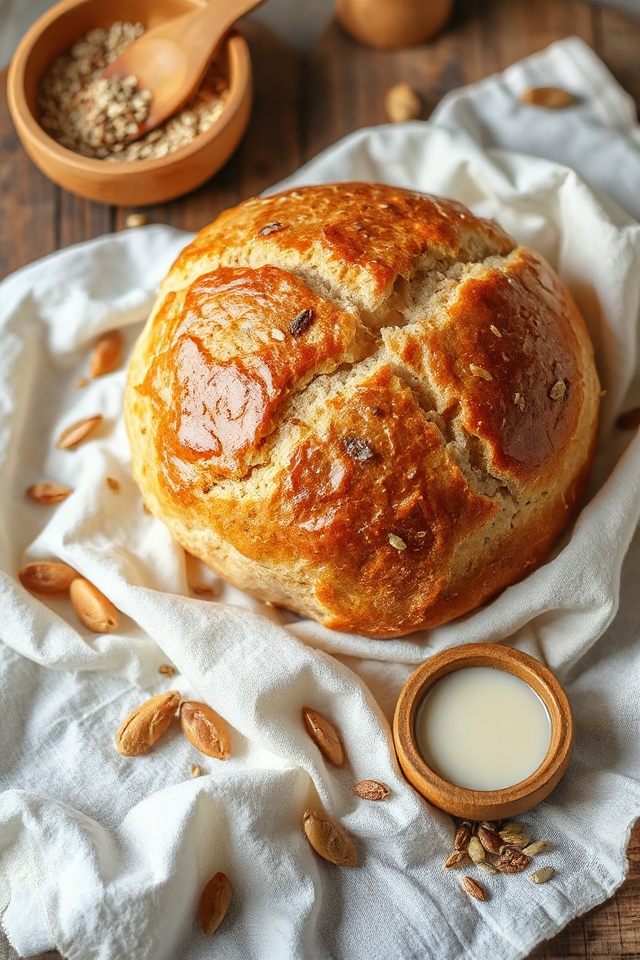Why You’ll Love This Buttermilk Bread Recipe
When you taste this buttermilk bread, you’ll understand why it’s become a favorite in my kitchen.
The moment you slice into it, you’ll be greeted by a golden crust that crackles beautifully. Each bite reveals a tender, moist crumb, infused with a hint of tang from the buttermilk.
It’s not just bread; it’s comfort food that pairs perfectly with butter or your favorite spreads. I love how easy it’s to make, allowing me to savor homemade goodness without a fuss.
Trust me, once you try it, you’ll be adding it to your regular baking rotation!
Ingredients of Buttermilk Bread
When it comes to whipping up a loaf of buttermilk bread, the ingredients are pretty straightforward. You don’t need a treasure trove of exotic items from the specialty store; just some staples you might already have in your pantry.
This recipe is all about simplicity, but that doesn’t mean you won’t be treated to a delightful flavor explosion. Trust me, the combination of buttermilk and seeds makes this bread not only delicious but also a bit nutritious.
So, let’s explore what you’ll need to gather before getting started.
Ingredients for Buttermilk Bread:
- 500 g flour
- 500 ml buttermilk
- 40 g fresh yeast cakes (that’s about one cake)
- 1 teaspoon salt
- 50 g sunflower seeds
- 50 g pumpkin seeds
- 50 g flax seeds
- 50 g sesame seeds
Now, when it comes to the ingredients, the flour is your base, and it’s essential to choose a good quality one for the best results. I like to use all-purpose flour, but if you’re feeling adventurous, you can mix in some whole wheat for added texture and flavor.
The buttermilk is where the magic happens; its tangy flavor really makes this bread stand out. And those seeds? They aren’t just for show. They add a fantastic crunch and boost your bread’s nutrition.
If you’re not a fan of one of the seeds listed, feel free to swap it out for something you like better—maybe some chopped nuts or even dried fruit for a sweet twist.
Just remember, baking is all about having fun, so don’t stress too much about sticking to the exact list. Let your creativity shine!
How to Make Buttermilk Bread

Making buttermilk bread is like starting a delightful adventure in your kitchen. Start by warming up 500 ml of buttermilk. You want it cozy, not boiling—just warm enough to invite 40 g of fresh yeast cakes to the party. Let that yeast mingle and dissolve for about 10 minutes.
Meanwhile, grab a bowl and mix together 500 g of flour and 1 teaspoon of salt. This is where your dough is going to get its structure, so don’t skimp on the flour.
Once the yeast is bubbly and happy, pour that buttermilk mixture into your flour and salt combo. Next, toss in 50 g each of sunflower, pumpkin, flax, and sesame seeds. Feel free to go wild with the seeds if you want to mix things up—just make sure you don’t use anything that’ll make you cringe.
Now, stir it all together until you have a dough that’s elastic but not sticking to your hands like a clingy friend. If it feels too wet, a sprinkle of flour will help; too dry? A splash more buttermilk will do the trick. Knead that dough with your hands for about 10 minutes, giving it some love and attention.
Once you’ve worked your dough into a lovely ball, cover it with a cloth and let it rise in a warm spot until it doubles in size. This part is like waiting for a surprise party to unfold, so maybe take a little break or clean up a bit.
After it’s risen, shape your dough into a round loaf and place it on a greased baking sheet. Cover it again and let it rise for another 30 minutes—this is the perfect time to preheat your oven to 250°C and set an ovenproof dish with boiling water at the bottom. This little trick creates steam for a nice, crusty exterior.
Once the loaf is ready, pop it in the oven for 10 minutes, then reduce the heat to 200°C and bake for about 45 minutes. When it’s done, give it a quick brush with cold water for that shiny crust. And just like that, you’ve got yourself a glorious loaf of buttermilk bread, ready to be devoured!
Buttermilk Bread Substitutions & Variations
If you’re looking to mix things up with your buttermilk bread, there are plenty of tasty substitutions and variations to contemplate.
You can swap out half the flour for whole wheat for a nuttier flavor or use Greek yogurt instead of buttermilk for a thicker texture.
Try adding chopped herbs like rosemary or thyme for an aromatic twist. If you’re feeling adventurous, toss in some dried fruits or nuts for added sweetness and crunch.
You can even experiment with different seeds or spices to personalize your loaf. The possibilities are endless, so don’t hesitate to get creative!
Additional Tips & Notes
To achieve the best results with your buttermilk bread, keep a few essential tips in mind.
First, make sure your buttermilk is warm but not hot—this helps activate the yeast effectively. If the dough feels too sticky, don’t hesitate to add a bit more flour; it should be elastic and manageable.
Kneading well is vital, so give it that full ten minutes. When rising, pick a warm spot; a cozy kitchen helps!
Finally, don’t skip brushing the crust with cold water after baking; it adds that beautiful shine.
Enjoy your baking adventure, and savor every slice of delicious bread!
